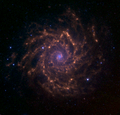Messier 74 facts for kids
Messier 74, also known as NGC 628 or the Phantom Galaxy, is a beautiful spiral galaxy located in the constellation of Pisces. It's a very distant neighbor, about 32 million light-years away from our home, Earth. Imagine how far that is!
Contents
What is a Galaxy?
A galaxy is like a giant island in space, filled with billions of stars, gas, and dust, all held together by gravity. Our own solar system, with the Sun and all its planets, is part of a galaxy called the Milky Way. Galaxies come in different shapes, and Messier 74 is a type called a spiral galaxy.
The Phantom Galaxy's Spiral Shape
What Makes a Spiral Galaxy Special?
Spiral galaxies are some of the most common and beautiful types of galaxies. They have a flat, rotating disk with spiral arms that reach out from a bright center. These arms are where many new stars are born. Messier 74 is a "grand-design" spiral galaxy, which means its spiral arms are very clear and well-defined.
Why is it Called the Phantom Galaxy?
Messier 74 gets its nickname, the "Phantom Galaxy," because it's quite faint and hard to see, even with a telescope. Its light is spread out over a large area, making it appear ghostly and dim in the night sky.
Finding Messier 74 in the Sky
Where is Pisces?
Messier 74 is found in the constellation Pisces, which means "the Fish" in Latin. Constellations are patterns of stars that people imagined in the sky long ago. Pisces is one of the 12 zodiac constellations. You can usually see it in the autumn sky in the Northern Hemisphere.
How Far is 32 Million Light-Years?
When we say Messier 74 is 32 million light-years away, it means the light we see from it today started its journey 32 million years ago! A light-year is the distance light travels in one year. Light travels incredibly fast, about 186,000 miles (300,000 kilometers) per second. So, 32 million light-years is an enormous distance, showing just how vast our universe is.
What Can We See in Messier 74?
Astronomers study galaxies like Messier 74 to learn more about how stars form and how galaxies evolve.
Supernovae in Messier 74
Messier 74 is a very active galaxy, meaning new stars are constantly being born there. Sometimes, very massive stars reach the end of their lives and explode in a spectacular event called a supernova. These explosions are incredibly bright and can outshine an entire galaxy for a short time. Astronomers have observed several supernovae in Messier 74, including SN 2013ej, which you can see in the main image of this article. Studying these supernovae helps scientists understand how stars die and how elements are spread throughout the universe.
Observing with Telescopes
Because Messier 74 is so far away and faint, astronomers use powerful telescopes to study it. They use different types of telescopes that can see different kinds of light, not just the light our eyes can see. For example, the Spitzer Space Telescope observes in infrared light, which helps scientists see through dust clouds and study star formation.
Images for kids
-
This image shows Messier 74 as seen by the Spitzer Space Telescope. The blue parts show light from stars. The green and red parts show light from tiny dust particles and special gases, which are often found where new stars are forming.
See also
 In Spanish: Galaxia espiral M74 para niños
In Spanish: Galaxia espiral M74 para niños



